Exchange Provisioning LDAP-Felder
Exchange nutzt natürlich das Active Directory zur Speicherung seiner Konfigurationsdaten. Auf dieser Seite widme ich den Feldern, die Exchange bei der Aktivierung eines Benutzers, Kontakte oder einer Gruppe schreibt. Ich habe dazu mit der MMC für Benutzer und Computer jeweils ein "Minimalobjekt" anlegt, welches nur die absolut erforderlichen Fehler hat und dann diese Objekte mit den Exchange Commandlets für Exchange aktiviert.
Diese IST-Aufnahme wurde mit Exchange 2010 auf Windows 2008 erhoben. Es gibt hier also keinen RUS mehr, der nachfolgend noch etwas an den Feldern dreht. Es kann aber sein, dass neuere Exchange oder AD-Management-Tools weitere Felder setzen.
Gemäß Microsoft ist es nicht unterstützt, die Exchange Properties per LDAP selbst direkt zu verändern. Der offiziell einzige Weg ist die Verwaltung per Exchange Powershell oder ECP.
Achtung
Diese Liste enthält die Felder, die bei einen Enable-* minimal addiert werden. Bei einem "Disable-* werden durchaus weitere Felder,
z.B. "ExtensionAttributes" mit gelöscht.
Mailbox
Zuerst habe ich einen minimalen Benutzer angelegt, der nur die absolut notwendigen Daten und die dann folgende Aktivierung für Exchange
| Feld | Wert | Enable-Mailbox |
|---|---|---|
dn |
CN=User,OU=test,DC=E2010,DC=local |
CN=User,OU=test,DC=E2010,DC=local |
changetype |
add |
add |
objectClass |
top |
top |
objectClass |
person |
person |
objectClass |
organizationalPerson |
organizationalPerson |
objectClass |
User |
User |
cn |
MailboxUser |
MailboxUser |
distinguishedName |
CN=MailboxUser,OU=test,DC=E2010,DC=local |
CN=MailboxUser,OU=test,DC=E2010,DC=local |
instanceType |
4 |
4 |
whenCreated |
20160320221915.0Z |
20160320221915.0Z |
whenChanged |
20160320221915.0Z |
20160320222724.0Z |
displayName |
MailboxUser |
MailboxUser |
uSNCreated |
1472119 |
1472119 |
uSNChanged |
1472124 |
1472152 |
name |
MailboxUser |
MailboxUser |
objectGUID |
uydmtQKdaEGUHR4+txcgGw== |
uydmtQKdaEGUHR4+txcgGw== |
UserAccountControl |
512 |
512 |
badPwdCount |
0 |
0 |
codePage |
0 |
0 |
countryCode |
0 |
0 |
badPasswordTime |
0 |
0 |
lastLogoff |
0 |
0 |
lastLogon |
0 |
0 |
pwdLastSet |
0 |
0 |
primaryGroupID |
513 |
513 |
objectSid |
AQUA...AAA== |
AQUA...AAA== |
accountExpires |
9223372036854775807 |
9223372036854775807 |
logonCount |
0 |
0 |
sAMAccountName |
MailboxUser |
MailboxUser |
sAMAccountType |
805306368 |
805306368 |
UserPrincipalName |
MailboxUser@E2010.local |
MailboxUser@E2010.local |
objectCategory |
CN=Person,CN=Schema, |
CN=Person,CN=Schema, |
dSCorePropagationData |
16010101000000.0Z |
16010101000000.0Z |
proxyAddresses |
SMTP:MailboxUser@e2010.local |
|
showInAddressBook |
CN=Default Global Address List,CN=All Global Address Lists,CN=Address Lists Container,CN=E2010Org,CN=Microsoft Exchange,CN=Services,CN=Configuration,DC=E2010,DC=local |
|
showInAddressBook |
CN=All Users,CN=All Address Lists,CN=Address Lists Container,CN=E2010Org,CN=Microsoft Exchange,CN=Services,CN=Configuration,DC=E2010,DC=local |
|
legacyExchangeDN |
/o=E2010Org/ou=Exchange Administrative Group (FYDIBOHF23SPDLT)/cn=Recipients/cn=User12f |
|
MailboxUser@e2010.local |
||
msExchWhenMailboxCreated |
20160320222724.0Z |
|
homeMTA |
CN=Microsoft MTA,CN=W2K8R2E2010,CN=Servers,CN=Exchange Administrative Group (FYDIBOHF23SPDLT),CN=Administrative Groups,CN=E2010Org,CN=Microsoft Exchange,CN=Services,CN=Configuration,DC=E2010,DC=local |
|
msExchMailboxSecurityDescriptor |
AQAEg.........AA |
|
msExchVersion |
44220983382016 |
|
msExchUMDtmfMap |
emailAddress8737 |
|
msExchUMDtmfMap |
lastNameFirstName8737 |
|
msExchUMDtmfMap |
firstNameLastName8737 |
|
msExchRecipientTypeDetails |
1 |
|
msExchHomeServerName |
/o=E2010Org/ou=Exchange Administrative Group (FYDIBOHF23SPDLT)/cn=Configuration/cn=Servers/cn=W2K8R2E2010 |
|
msExchRecipientDisplayType |
1073741824 |
|
mDBUseDefaults |
TRUE |
|
msExchRBACPolicyLink |
CN=Default Role Assignment Policy,CN=Policies,CN=RBAC,CN=E2010Org,CN=Microsoft Exchange,CN=Services,CN=Configuration,DC=E2010,DC=local |
|
mailNickname |
User |
|
msExchMailboxGuid |
HYEjIyuctkSdVb7mtZiKIw== |
|
homeMDB |
CN=MB1,CN=Databases,CN=Exchange Administrative Group (FYDIBOHF23SPDLT),CN=Administrative Groups,CN=E2010Org,CN=Microsoft Exchange,CN=Services,CN=Configuration,DC=E2010,DC=local |
|
msExchUserAccountControl |
0 |
|
msExchPoliciesIncluded |
4b15b55c-a56f-45b3-b215-f76fc0049458 |
|
msExchPoliciesIncluded |
{26491cfc-9e50-4857-861b-0cb8df22b5d7} |
Hier sind keine Überraschungen zu sehen.
Remote Mailbox
Eine Besonderheit sind Postfächer, die in Office 365 angelegt werden. On-Prem ist es ein AD-User, der aber direkt in der Cloud provisioniert wird
| Feld | Wert | Enable-RemoteMailbox |
|---|---|---|
dn |
CN=RemoteMailbox,OU=test,DC=E2010,DC=local |
CN=RemoteMailbox,OU=test,DC=E2010,DC=local |
changetype |
add |
add |
objectClass |
top |
top |
objectClass |
person |
person |
objectClass |
organizationalPerson |
organizationalPerson |
objectClass |
User |
User |
cn |
RemoteMailbox |
RemoteMailbox |
distinguishedName |
CN=RemoteMailbox,OU=test,DC=E2010,DC=local |
CN=RemoteMailbox,OU=test,DC=E2010,DC=local |
instanceType |
4 |
4 |
whenCreated |
20160320225436.0Z |
20160320225436.0Z |
whenChanged |
20160320225437.0Z |
20160320233543.0Z |
displayName |
RemoteMailbox |
RemoteMailbox |
uSNCreated |
1472211 |
1472211 |
uSNChanged |
1472211 |
1472217 |
name |
RemoteMailbox |
RemoteMailbox |
objectGUID |
Vpyr3wzQREaGIri74vDLTg== |
Vpyr3wzQREaGIri74vDLTg== |
UserAccountControl |
512 |
512 |
badPwdCount |
0 |
0 |
codePage |
0 |
0 |
countryCode |
0 |
0 |
badPasswordTime |
0 |
0 |
lastLogoff |
0 |
0 |
lastLogon |
0 |
0 |
pwdLastSet |
0 |
0 |
primaryGroupID |
513 |
513 |
objectSid |
AQUA...AAA== |
AQUA...AAA== |
accountExpires |
9223372036854775807 |
9223372036854775807 |
logonCount |
0 |
0 |
sAMAccountName |
RemoteMailbox |
RemoteMailbox |
sAMAccountType |
805306368 |
805306368 |
UserPrincipalName |
RemoteMailbox@E2010.local |
RemoteMailbox@E2010.local |
objectCategory |
CN=Person,CN=Schema, |
CN=Person,CN=Schema, |
dSCorePropagationData |
16010101000000.0Z |
16010101000000.0Z |
proxyAddresses |
SMTP:RemoteMailbox@e2010.local |
|
proxyAddresses |
smtp:RemoteMailbox@carius.onmicrosoft.com |
|
showInAddressBook |
CN=Default Global Address List,CN=All Global Address Lists,CN=Address Lists Container,CN=E2010Org,CN=Microsoft Exchange,CN=Services,CN=Configuration,DC=E2010,DC=local |
|
showInAddressBook |
CN=All Users,CN=All Address Lists,CN=Address Lists Container,CN=E2010Org,CN=Microsoft Exchange,CN=Services,CN=Configuration,DC=E2010,DC=local |
|
legacyExchangeDN |
/o=E2010Org/ou=Exchange Administrative Group (FYDIBOHF23SPDLT)/cn=Recipients/cn=RemoteMailbox938 |
|
RemoteMailbox@e2010.local |
||
targetAddress |
SMTP:RemoteMailbox@carius.onmicrosoft.com |
|
msExchVersion |
44220983382016 |
|
|
msExchRemoteRecipientType |
1 |
|
msExchUMDtmfMap |
emailAddress78737 |
|
msExchUMDtmfMap |
lastNameFirstName78737 |
|
msExchUMDtmfMap |
firstNameLastName78737 |
|
|
msExchRecipientTypeDetails |
2147483648 |
|
|
msExchRecipientDisplayType |
-2147483642 |
|
mailNickname |
RemoteMailbox |
|
msExchPoliciesIncluded |
4b15b55c-a56f-45b3-b215-f76fc0049458 |
|
msExchPoliciesIncluded |
{26491cfc-9e50-4857-861b-0cb8df22b5d7} |
Im Vergleich zur normalen Mailbox auf dem lokalen Exchange Server habe ich die Abweichungen blau kenntlich gemacht.
MailUser
Ein MailUser ist ein aktives Anmeldekonto, welches aber sein Postfach nicht in der lokalen Exchange Umgebung hat, sondern extern. Dies ist ein klassischer Fall, wenn externe Personen für eine Firma arbeiten, die ein Anmeldekonto benötigen aber ihre Mails in einem anderen System bearbeiten, sie aber dennoch in der Adressliste erscheinen und in Verteilern Mitglied sein können.
| Feld | Wert | Enable-MailUser |
|---|---|---|
dn |
CN=MailUser,OU=test,DC=E2010,DC=local |
CN=MailUser,OU=test,DC=E2010,DC=local |
changetype |
add |
add |
objectClass |
top |
top |
objectClass |
person |
person |
objectClass |
organizationalPerson |
organizationalPerson |
objectClass |
User |
User |
cn |
MailUser |
MailUser |
distinguishedName |
CN=MailUser,OU=test,DC=E2010,DC=local |
CN=MailUser,OU=test,DC=E2010,DC=local |
instanceType |
4 |
4 |
whenCreated |
20160320222712.0Z |
20160320222712.0Z |
whenChanged |
20160320222712.0Z |
20160320222822.0Z |
displayName |
MailUser |
MailUser |
uSNCreated |
1472143 |
1472143 |
uSNChanged |
1472143 |
1472156 |
name |
MailUser |
MailUser |
objectGUID |
PC5e/YhyR0KzgNLc5kphdg== |
PC5e/YhyR0KzgNLc5kphdg== |
UserAccountControl |
512 |
512 |
badPwdCount |
0 |
0 |
codePage |
0 |
0 |
countryCode |
0 |
0 |
badPasswordTime |
0 |
0 |
lastLogoff |
0 |
0 |
lastLogon |
0 |
0 |
pwdLastSet |
0 |
0 |
primaryGroupID |
513 |
513 |
objectSid |
AQUA..AAA== |
AQUA...AA== |
accountExpires |
9223372036854775807 |
9223372036854775807 |
logonCount |
0 |
0 |
sAMAccountName |
MailUser |
MailUser |
sAMAccountType |
805306368 |
805306368 |
UserPrincipalName |
MailUser@E2010.local |
MailUser@E2010.local |
objectCategory |
CN=Person,CN=Schema, |
CN=Person,CN=Schema, |
dSCorePropagationData |
16010101000000.0Z |
16010101000000.0Z |
proxyAddresses |
smtp:MailUser@e2010.local |
|
proxyAddresses |
SMTP:MailUser@example.com |
|
showInAddressBook |
CN=Default Global Address List,CN=All Global Address Lists,CN=Address Lists Container,CN=E2010Org,CN=Microsoft Exchange,CN=Services,CN=Configuration,DC=E2010,DC=local |
|
showInAddressBook |
CN=All Users,CN=All Address Lists,CN=Address Lists Container,CN=E2010Org,CN=Microsoft Exchange,CN=Services,CN=Configuration,DC=E2010,DC=local |
|
legacyExchangeDN |
/o=E2010Org/ou=Exchange Administrative Group (FYDIBOHF23SPDLT)/cn=Recipients/cn=MailUser23c |
|
MailUser@example.com |
||
targetAddress |
SMTP:MailUser@example.com |
|
msExchVersion |
44220983382016 |
|
msExchUMDtmfMap |
emailAddress68737 |
|
msExchUMDtmfMap |
lastNameFirstName68737 |
|
msExchUMDtmfMap |
firstNameLastName68737 |
|
msExchRecipientTypeDetails |
128 |
|
msExchRecipientDisplayType |
6 |
|
internetEncoding |
1310720 |
|
mailNickname |
MailUser |
|
msExchPoliciesIncluded |
4b15b55c-a56f-45b3-b215-f76fc0049458 |
|
msExchPoliciesIncluded |
{26491cfc-9e50-4857-861b-0cb8df22b5d7} |
MailContact
Ein Mailkontakt ist zu einem MailUser vergleichbar, nur dass er kein Anmeldekonto hat, Dieser Benutzer erscheint also nur im Adressbuch aber kann sich nicht an der Domäne anmelden.
| Feld | Wert | Enable-Mailcontact |
|---|---|---|
dn |
CN=Contact,OU=test,DC=E2010,DC=local |
CN=Contact,OU=test,DC=E2010,DC=local |
changetype |
add |
add |
objectClass |
top |
top |
objectClass |
person |
person |
objectClass |
organizationalPerson |
organizationalPerson |
objectClass |
contact |
contact |
cn |
MailContact |
MailContact |
distinguishedName |
CN=MailContact,OU=test,DC=E2010,DC=local |
CN=MailContact,OU=test,DC=E2010,DC=local |
instanceType |
4 |
4 |
whenCreated |
20160320221929.0Z |
20160320221929.0Z |
whenChanged |
20160320221929.0Z |
20160320222739.0Z |
uSNCreated |
1472125 |
1472125 |
uSNChanged |
1472125 |
1472153 |
name |
MailContact |
MailContact |
objectGUID |
9no6yT/ZDkWCdlR6FFPGSQ== |
9no6yT/ZDkWCdlR6FFPGSQ== |
objectCategory |
CN=Person,CN=Schema, |
CN=Person,CN=Schema, |
dSCorePropagationData |
16010101000000.0Z |
16010101000000.0Z |
displayName |
MailContact |
|
proxyAddresses |
smtp:MailContact@e2010.local |
|
proxyAddresses |
SMTP:extern@example.com |
|
showInAddressBook |
CN=Default Global Address List,CN=All Global Address Lists,CN=Address Lists Container,CN=E2010Org,CN=Microsoft Exchange,CN=Services,CN=Configuration,DC=E2010,DC=local |
|
showInAddressBook |
CN=All Contacts,CN=All Address Lists,CN=Address Lists Container,CN=E2010Org,CN=Microsoft Exchange,CN=Services,CN=Configuration,DC=E2010,DC=local |
|
legacyExchangeDN |
/o=E2010Org/ou=Exchange Administrative Group (FYDIBOHF23SPDLT)/cn=Recipients/cn=Contact272 |
|
extern@example.com |
||
targetAddress |
SMTP:extern@example.com |
|
msExchVersion |
44220983382016 |
|
msExchUMDtmfMap |
emailAddress398376 |
|
msExchUMDtmfMap |
lastNameFirstName2668228 |
|
msExchUMDtmfMap |
firstNameLastName2668228 |
|
msExchRecipientDisplayType |
6 |
|
internetEncoding |
1310720 |
|
mailNickname |
MailContact |
|
msExchPoliciesIncluded |
4b15b55c-a56f-45b3-b215-f76fc0049458 |
|
msExchPoliciesIncluded |
{26491cfc-9e50-4857-861b-0cb8df22b5d7} |
Er unterscheidet sich zum MailUser eigentlich nur im Fehlen des Feldes "msExchRecipient TypeDetails".
Gruppe
In diesem Beispiel habe ich eine "Universal Security Group" als Basis genommen. Exchange unterstützt nur universelle Gruppen. Sie müssen aber nicht unbedingt auch eine SID haben. Reine "Verteilergruppen" gehen auch, die aber zu Securitygruppen werden, sobald diese für die Vergabe von Berechtigungen z.B. auf öffentlichen Ordnern oder Postfächern genutzt werden.
| Feld | Wert | Enable-Distributiongroup |
|---|---|---|
dn |
CN=group,OU=test,DC=E2010,DC=local |
CN=group,OU=test,DC=E2010,DC=local |
changetype |
add |
add |
objectClass |
top |
top |
objectClass |
group |
group |
cn |
group |
group |
distinguishedName |
CN=group,OU=test,DC=E2010,DC=local |
CN=group,OU=test,DC=E2010,DC=local |
instanceType |
4 |
4 |
whenCreated |
20160320221852.0Z |
20160320221852.0Z |
whenChanged |
20160320221852.0Z |
20160320222854.0Z |
uSNCreated |
1472109 |
1472109 |
uSNChanged |
1472109 |
1472159 |
name |
group |
group |
objectGUID |
g3jnObdyvk24wRpJ92fdmQ== |
g3jnObdyvk24wRpJ92fdmQ== |
objectSid |
AQUA....AAA== |
AQUA....AAA== |
sAMAccountName |
group |
group |
sAMAccountType |
268435456 |
268435456 |
groupType |
-2147483640 |
-2147483640 |
objectCategory |
CN=Group,CN=Schema, |
CN=Group,CN=Schema, |
dSCorePropagationData |
16010101000000.0Z |
16010101000000.0Z |
proxyAddresses |
SMTP:group@e2010.local |
|
showInAddressBook |
CN=Default Global Address List,CN=All Global Address Lists,CN=Address Lists Container,CN=E2010Org,CN=Microsoft Exchange,CN=Services,CN=Configuration,DC=E2010,DC=local |
|
showInAddressBook |
CN=All Groups,CN=All Address Lists,CN=Address Lists Container,CN=E2010Org,CN=Microsoft Exchange,CN=Services,CN=Configuration,DC=E2010,DC=local |
|
legacyExchangeDN |
/o=E2010Org/ou=Exchange Administrative Group (FYDIBOHF23SPDLT)/cn=Recipients/cn=group153 |
|
group@e2010.local |
||
msExchRequireAuthToSendTo |
TRUE |
|
msExchVersion |
44220983382016 |
|
msExchRecipientDisplayType |
1073741833 |
|
reportToOriginator |
TRUE |
|
mailNickname |
group |
|
msExchPoliciesIncluded |
4b15b55c-a56f-45b3-b215-f76fc0049458 |
|
msExchPoliciesIncluded |
{26491cfc-9e50-4857-861b-0cb8df22b5d7} |
Disable-* (Deprovisioning)
Achtung
Beim Deprovisionieren von Exchange Objekten mit Disable-*
werden nicht nur die oben genannten minimalen Attribute
entfernt, sondern auch weitere Fehler, die prinzipiell von
Exchange verwaltet aber oft zweckentfremdet werden. z.B. "ExtensionAttributes"
Aus dem Grund kann es sinnvoll sein, den "Disable" manuell zu machen. Es ist natürlich etwas mehr Arbeit als die Exchange Commandlets zu nutzen und man sollte auch sehr sicher sein, welche Attribute gelöscht werden dürfen und "Supported" ist es sowieso nicht.
Wenn Sie aber den letzten Exchange Server deinstallieren wollen, keinen Hybrid-Mode mit der Cloud haben etc., dann kann dies helfen.
Set-ADUser `
-identity altuser@msxfaq.de `
-Clear mail, `
HomeMDB, `
HomeMTA, `
legacyExchangeDN, `
mDBUseDefaults, `
msExchMailboxAuditEnable, `
msExchAddressBookFlags, `
msExchArchiveQuota, `
msExchArchiveWarnQuota, `
msExchBypassAudit, `
msExchDisabledArchiveDatabaseLink, `
msExchDisabledArchiveGUID, `
msExchDumpsterQuota, `
msExchDumpsterWarningQuota, `
msExchHomeServerName, `
msExchMailboxAuditEnable, `
msExchMailboxAuditLogAgeLimit, `
msExchMailboxGuid, `
msExchMailboxSecurityDescriptor, `
msExchMDBRulesQuota, `
msExchModerationFlags, `
msExchOmaAdminWirelessEnable, `
msExchPreviousRecipientTypeDetails, `
msExchPoliciesIncluded, `
msExchPoliciesExcluded, `
msExchProvisioningFlags, `
msExchRBACPolicyLink, `
msExchRecipientDisplayType, `
msExchRecipientSoftDeletedStatus", `
msExchRecipientTypeDetails, `
msExchRemoteRecipientType, `
msExchTransportRecipientSettingsFlags, `
msExchUMDtmfMap, `
msExchUMEnabledFlags2, `
msExchUserAccountControl, `
msExchVersion, `
msExchWhenMailboxCreated, `
protocolSettings, `
proxyAddresses, `
showInAddressBook, `
targetAddress, `
mailNickname
reportToOriginator
internetEncoding
}
Der Code deaktiviert einen Benutzer (Mailbox, RemoteMailbox, RoomMailbox, SharedMailbox) aber lässt z.B. die ExtensionAttributes0-15 unberührt. Sie können auch noch Mail und ProxyAddresses entfernen, wenn Sie die diese Informationen für andere Zwecke benötigen.
Ein für Exchange relevantes Objekt muss zumindest einen "MailNickname" haben.
- Disable-Mailbox
https://docs.microsoft.com/de-de/powershell/module/exchange/disable-mailbox?view=exchange-ps - Deaktivieren oder Löschen eines Postfachs in Exchange Server
https://docs.microsoft.com/de-de/exchange/recipients/disconnected-mailboxes/disable-or-delete-mailboxes - Exchange Attribute Retention After Mailbox Removal
https://blog.rmilne.ca/2015/09/14/exchange-attribute-retention-after-mailbox-removal/
Weitere Links
- AD Felder
- LDAP-Felder
- Exchange Felder
- EX55 Felder
- msExchRecipient TypeDetails
-
Exchange Online Provisioning
So werden Exchange Online Postfächer mit AADConnect korrekt provisioniert
